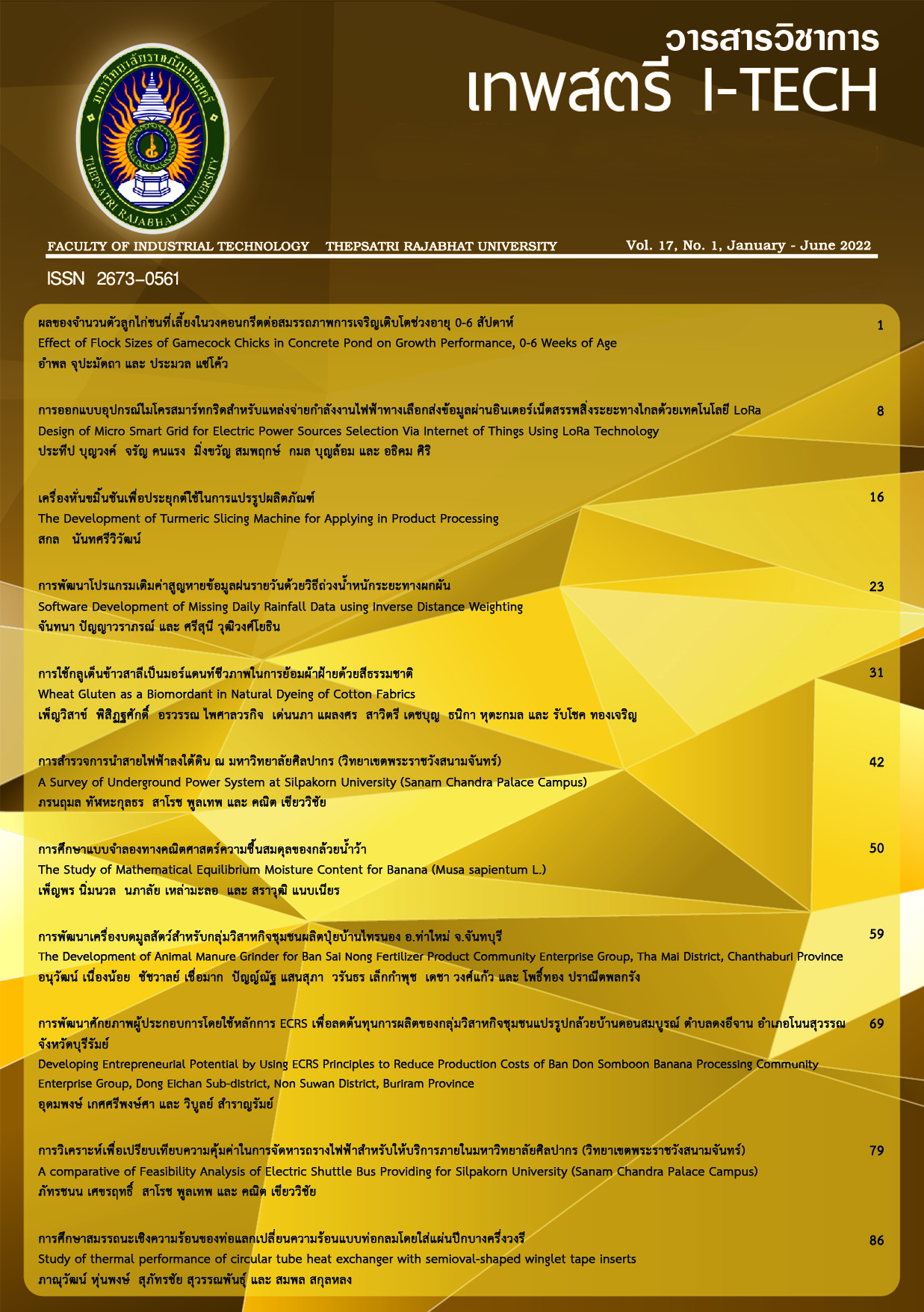การใช้กลูเต็นข้าวสาลีเป็นมอร์แดนท์ชีวภาพในการย้อมผ้าฝ้ายด้วยสีธรรมชาติ
Abstract
งานวิจัยนี้ศึกษาการใช้กลูเต็นข้าวสาลีเป็นมอร์แดนท์ชีวภาพ เพื่อย้อมผ้าฝ้ายด้วยสีธรรมชาติที่อุดมด้วยสารแทนนิน โดยสีผงธรรมชาติที่ใช้ย้อมได้จากการนำสารสกัดจากเปลือกไม้ตะบูนขาวมาผ่านการอบแห้งแบบพ่นละอองฝอย ในการใช้ผงกลูเต็นข้าวสาลีทำโดยนำผงกลูเต็นข้าวสาลีไปละลายน้ำที่พีเอช 12 จากนั้นนำสารละลายที่ได้ไปจุ่มอัดบนผ้าฝ้ายก่อนทำการย้อม พบว่ามีผลเป็นมอร์แดนท์ชีวภาพที่ช่วยให้ความเข้มสีของผ้าที่ย้อมได้สูงขึ้น โดยความเข้มข้นของโปรตีนกลูเต็นข้าวสาลี ค่าพีเอช ระยะเวลาในการย้อม และอุณหภูมิต่อความเข้มสีล้วนมีผลต่อความเข้มสีที่ได้ สำหรับสภาวะการย้อมสีที่เหมาะสมคือการใช้กลูเต็นข้าวสาลีความเข้มข้น 0.5% w/v, ความเข้มข้นสีย้อม 30% owf, อุณหภูมิการย้อม 90 องศาเซลเซียส, ระยะเวลาในการย้อม 45 นาที, ค่าอัตราส่วน L:R เท่ากับ 1:30 และพีเอช 5 นอกจากนี้ยังทำการศึกษาผลของการใช้กลูเต็นข้าวสาลีต่อค่าความคงทนของสีต่อการซัก ความคงทนของสีต่อแสง เหงื่อ การขัดถู และทดสอบสมบัติเชิงกล ได้แก่ ความต้านทานการฉีกขาด และความต้านทานแรงดึง
References
L. Day, M. Augustin, I. Batey, and C. Wrigley, “Wheat-gluten uses and industry needs,” Trends in Food Science and Technology, vol. 17, no. 2, pp. 82-90, Feb. 2006.
P. Wang, Z. Jin, and X. Xu, “Physicochemical alterations of wheat gluten proteins upon dough formation and frozen storage –A review from gluten, glutenin and gliadin perspectives,” Trends in Food Science and Technology, vol. 46, no. 2, pp. 189-198, Dec. 2015.
E. Abedi, and K. Pourmohammadi, “Physical modifications of wheat gluten protein: An extensive review” Journal of Food Process Engineering, vol. 44, no. 3, e13619, Mar. 2021.
M. Majzoobi, E. Abedi, “Effects of pH changes on functional properties of native and acetylated wheat gluten,” International Food Research Journal, vol. 21, no. 3, pp. 1219-1224, Dec. 2014.
A. Haji, “Improved natural dyeing of cotton by plasma treatment and chitosan coating; optimization by response surface methodology,” Cellulose Chemistry and Technology, vol. 51, no. 9-10, pp. 975-982, Sep.-Dec. 2017.
S. Janhom, R. Watanesk, S, Watanesk, P. Griffiths, O. A. Arquero, and W. Naksata, “Comparative study of lac dye adsorption on cotton fibre surface modified by synthetic and natural polymers,” Dyes and Pigments, vol. 71, no. 3, pp. 188-193, Sep. 2006.
P. Pisitsak, J. Hutakamol, S. Jeenapak, P. Wanmanee, J. Nuammaiphum, and R. Thongcharoen, “Natural dyeing of cotton with Xylocarpus granatum bark extract: Dyeing, fastness, and ultraviolet protection properties,” Fibers and Polymers, vol. 17, pp. 560-558, Apr. 2016.
M. B.Ticha, W. Haddar, M. Meksi, A. Guesmi, and M. F. Mhenni, “Improving dyeability of modified cotton fabrics by the natural aqueous extract from red cabbage using ultrasonic energy,” Carbohydrate Polymers, vol. 154, pp. 287-295, Dec. 2016.
.[9] P. S. Vankar, R. Shanker, and A. Verma, “Enzymatic natural dyeing of cotton and silk fabrics without metal mordants,” Journal of Cleaner Production, vol. 15, no. 15, pp. 1441-1450, Oct. 2007.
P. S. Vankar, R. Shanker, D. Mahanta, D. And S. Tiwari, “Ecofriendly sonicator dyeing of cotton with Rubia cordifolia Linn. using biomordant,” Dyes and Pigments, vol. 76, no. 1, pp. 207-212, Jan. 2008.
F. Giacomini, A. A. U. de Souza, and M .A. S. D. de Barros, “Cationization of cotton with ovalbumin to improve dyeing of modified cotton with cochineal natural dye,” Textile Research Journal, vol. 90, no. 15-16, pp. 1805-1822, Jan. 2020.
P. Pisitsak, J. Hutakamol, R. Thongcharoen, P. Phokaew, K. Kanjanawan, and N. Saksaeng, “Improving the dyeability of cotton with tannin-rich natural dye through pretreatment with whey protein isolate,” Industrial Crops and Products, vol. 79, pp. 47-56, Jan. 2016.
P. Pisitsak, N. Tungsombatvisit, and K. Singhanu, “Utilization of waste protein from Antarctic krill oil production and natural dye to impart durable UV-properties to cotton textiles,” Journal of Cleaner Production, vol. 174, pp. 1215-1223, Feb. 2018.
S. Uthayakumaran, and C. W. Wrigley, “Wheat: characteristics and quality requirements,” In Cereal Grains, Woodhead Publishing, Cambridge, UK, 2010, pp. 59-111.
B. G. Thewissen, I., Celus, K. Brijs, and J. A. Delcour, “Foaming properties of wheat gliadin,” Journal of Agricultural and Food Chemistry, vol. 59, no. 4, pp. 1370-1375, Jan. 2011.
L. Donato, E. Kolodziejcyk, and M. Rouvet, “Mixtures of whey protein microgels and soluble aggregates as building blocks to control rheology and structure of acid induced cold-set gels,” Food Hydrocolloids, vol. 25, no. 4, pp. 734-742, Jun. 2011.
T. N. Asquith, and L. G. Butler, “Interactions of condensed tannins with selected proteins,” Phytochemistry, vol. 25, no. 7, pp. 1591-1593, Nov. 1985.
D. K. Salunkhe, J. K. Chavan, and S. S. Kadam, in Dietary Tannins: Consequences and Remedies, 1st ed. CRC Press, Florida, 1989, ch. 1, pp. 1-3.
M. Mejri, B. Rogé, A. BenSouissi, F. Michels, and M. Mathlouthi, “Effects of some additives on wheat gluten solubility: A structural approach,” Food Chemistry, vol. 92, no. 1, pp. 7-15, Jan. 2005.
M. Majzoobi, and E. Abedi, “Effects of pH changes on functional properties of native and acetylated wheat gluten,” International Food Research Journal, vol 21, no. 3, pp. 1219-1224, May 2014.
A. E. Hagerman, “Chemistry of tannin-protein complexation,” In Chemistry and Significance of Condensed Tannins, Springer, Germany, 1989, pp 323-333.
E. R. Deaville, R. J. Green, I. Mueller-Harvey, I. Willoughby, and R. A. Frazier, “Hydrolyzable tannin structures influence relative globular and random coil protein binding strengths,” Journal of Agricultural and Food Chemistry, vol. 55, no. 11, pp. 4454-4561, May 2007.
S. Rattanaphani, M. Chairat, J. B. Bremner, and V. Rattanaphani, “An adsorption and thermodynamic study of lac dyeing on cotton pretreated with chitosan,” Dyes and Pigments, vol. 72, pp. 88-96, Oct. 2005.
G. N. Ramaswamy, J. Wang, and B. Soeharto, “Mercerization and dyeing of kenaf/cotton blend fabrics,” Textile Chemists and Colorists, vol. 31, no. 3, pp. 27-31, Mar. 1999.

